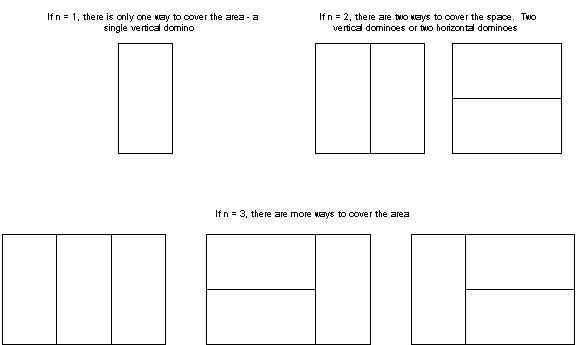There are many applications in which a large space needs to be covered with
"tiles". For example, the space above the stove in a kitchen, or the walls
inside a shower in the bathroom, or an educational child's puzzle.
If the tiles are square, then there is only one pattern that can be used to cover the space.
But if the tiles are not square, then many different patterns might be possible.
Dominoes are rectangular shapes which are 2 inches by 1 inch (2" x 1") in size.
In this project, you will write a program to determine and display
all the different patterns that can be used to cover a rectangular area
with dominoes.
The area to be covered will be 2-inches wide and N inches long, where N is a
command line argument. Obviously, the larger value N has, the more
ways there will be to cover the area.
After some thought, you'll find that this is a problem which is best solved
recursively and will require multiple recursive functions.
Your program, and ALL programs in this class, must handle the following errors:
Project Design Assignment
This project requires that you submit a project design text file by
midnight, Sunday Sept 15th. The file may be named whatever you like, but it must
be a plain text file.
At a minimum, your design submittal must inlcude the following
- An explanation of the basic algorithm you will use.
- A description of each major function. This description must include the
function's name, the function's return type, a description of each parameter,
and description of what the function does.
- A description of any major data item (arrays, structs, etc), including
its purpose, limitations and scope.
Submit your file using the submit command.
submit cs202 Proj1 design.txt
Project Make File
The "make" utility is used to help control projects with large numbers of files.
It consists of targets, rules, and dependencies. You will be learning about
make files in discussion. For this project, the file will be provided for you.
You will be responsible for providing make files for all future projects.
Copy the file
/afs/umbc.edu/users/d/e/dennis/pub/CMSC202/p1/Makefile
to your directory.
When you finish creating all of the required project files (proj1.C,
domino.C and domino.H, you will find that by typing the command make
or make Proj1 at the Linux prompt, your project will compile
and link (if there are no compiler or linker errors) and produce an executable
called Proj1.
If you name your files anything other than proj1.C, domino.C
and domino.H, or if you create additional files, it is your responsibility
to provide your own makefile. Any project that does not compile and link
without errors simply by typing the command make Proj1
will be considered to have a compiler/linker error.
In addition to creating your project executable, make can be used
for maintaining your directory. Typing make clean will remove any
extraneous files in your directory, such as .o files and core files.
Typing make cleanest will remove all .o files, core, Proj1,
and backup files created by the editor.
See the 202 Syllabus
for links to more information on make files.
Grading
The grade for this project will be broken down as follows. A more detailed
breakdown will be provided in the grade form you recieve from the grader.
- 70% - Correctness
- The program produces the correct output
- The program meets all project specification, including but not limited to errors
- 10% - Design
- Your design assignment was submitted on time
- Your design assignment meets the minimum requirements described above
- You code represents "good" top-down design and matches the design you submitted
to a reasonable degre.
- 20% - Coding Standards
Project Submission
You must use separate compilation for this project. You must have a file called
proj1.C that contains the function main(). You should also have a
domino.C and a domino.H that contain the
functions used by proj1.C and the prototypes for those functions,
respectively. (Note the uppercase "C" and uppercase "H".) Submit as follows:
submit cs202 Proj1 proj1.C domino.C domino.H Makefile
The order in which the files are listed doesn't matter. However, you must make
sure that all files necessary to compile your project (using the make file)
are listed.
You can check to see what files you have submitted by typing
submitls cs202 Proj1
More complete documentation for submit and related commands can be found
here.
Remember -- if you make any change to your program, no matter how
insignificant it may seem, you should recompile and retest your program before
submitting it. Even the smallest typo can cause compiler errors and a reduction
in your grade.
